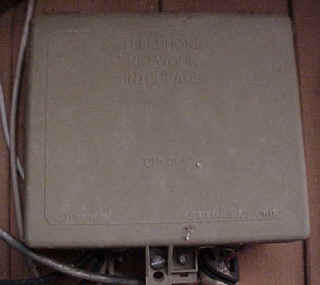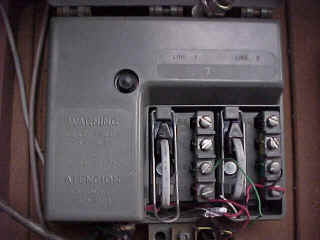
|
|

| Troubleshooting | News | Technical | Search |
| Home | Forum 56 | Premium | Site Map |
 |
|
||||||||
 |
|
||||||||
| Home • Troubleshooting • Checking your phone line |Testing Phone Wiring - DEMARC | |||||||||
This part of "modem tweaking" is easy! Sometimes something connected to your phone line - another telephone, fax machine, cordless, etc. - will cause your modem performance to suffer. Sometimes something in your wiring - a rusty/loose phone jack, poor connection or routing, etc. - can do the same.
Easy: Unplug everything from the phone line except the modem. Dial your ISP. Does the modem work faster or better? (Read more.)
Not quite as easy: Connect to the demarc as explained below.
| The easiest way to check the wiring
in your house - and at the same time eliminate any other devices plugged into
the phone line as a source of trouble - is to connect your modem directly to the
Telephone Network Interface. This is a telco-provided box, usually on the
outside of your premises, and is also known as the 'demarc' - it is the point
where the telco's wiring responsibility ends and yours begins. Modern telco
Network Interfaces have a standard line jack with a modular cable inserted.
Unplugging this cable will disconnect all of your inside phone wiring.
Pictured to the right is (top) a closed Telephone Network Interface on the outside of my house; this box can accommodate 2 phone lines. It is opened by loosening the screw at the bottom center of the box. The cover swings up, and exposes the modular connectors for Lines 1 and 2, as well as the terminal blocks for connection of inside wiring. Unplugging the modular cable (on this box, the metal clip must be pulled back to pull out the modular connector) breaks the connection to the terminal strip. Note each line's strip has 4 positions (Red, Green. Yellow & Black), but only Red & Green carry a telco signal. If you have a long enough cable, use a cord between your modem and the Network Interface - plug it in directly. If your connection improves, you can further isolate the problem by unplugging phone devices, trying other line cords, or removing wiring runs. Note also that the Network Interface has a cover bolted over a portion of the opened box. This is 'telco-only' area - and is where the cable from the street is connected, grounded, and in many cases protected with lightning arrestors or fuses. A bad fuse in the box - telco responsibility - can cause trouble. |
 Above - Unopened Telephone Network Interface Below - Same box, opened.  There are variations in the appearance and design of Telco Network Interface Boxes. Some have a second jack that, if you plug a phone (or modem) into, disconnects your inside wiring (ie, you don't unplug anything - simply plugging in to the jack disconnects your normal wiring). |
IF you are unable to test by plugging your modem into the Network Interface:Unplug all other telephone devices from any jack on your premises that connects to the line you use for your modem: fax machine, answering machine, cordless phones, regular phones, etc. If this makes a difference in connect rate or disconnections, plug the devices back in one at a time to isolate the problem device. Also make sure the phone cord from modem to jack is in good shape - try another cord if possible.
If you have more than 1 cable wired to the Network Interface's terminal block, you can disconnect all but the one that goes to the jack near your computer and eliminate problems with the wiring to at least some of the other jacks.
The best way to connect a modem to your phone line:
Nearly all modems have two phone jacks: line and phone. Since most modems disconnect the phone outlet when the modem is in use, you can eliminate all other devices and wiring if they are connected to the phone outlet of your modem.
The simplest way to describe how to do this would be to run a line cord or wire from your modem's line jack to the demarc and plug this cord into the jack on the demarc pictured above; you would then run a line cord or wire from your modem's phone jack to the demarc, and plug the cord you removed from the demarc into this cord (either by using a m-m adapter or by using a line cord that has female end at demarc.)
There are a number of other ways to do this, but all produce the same result: When the modem is off-hook (in use), all other devices (fax, phones, answering machines, cordless, etc.) are disconnected from the line.
[Note: Prior to telco change that improved my 56k connects, I had tested the modem connected directly to demarc and had no performance improvement. Recently, I tested again, and found that when connected directly, my connect rate and reliability/error-rate had marked improvement. I modified the wiring for the phone line so my first modem is connected directly to the demarc, the second modem is connected to the first modem, and all other phone device/wiring is connected to the second modem. With this arrangement, someone cannot accidentally pick up a phone, which otherwise usually causes data errors/retrain.]
Anything connected to your phone line, as well as the integrity of your phone wiring can affect your modem. This can include alarm service devices or medical lifeline services that use your phone line. Gill from the UK writes "I have Redcare connected to my phone line as part of my security system. My old v.90 modem connected with no problems, but new v.92 modem would only connect very occasionally at very slow speeds 9-16k bps." His alarm company sells a "modem compatibility device" which solved the problem.
| Home | Links | Send
Feedback | Privacy Policy | Report Broken Link Legal Page | Author's Web Sites | Log In |
|
Modemsite.com ©1998-2022 v.Richard Gamberg. All rights reserved. |